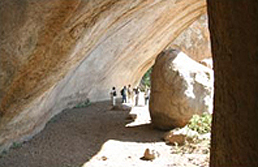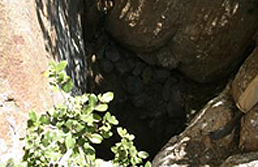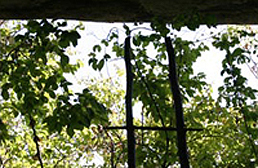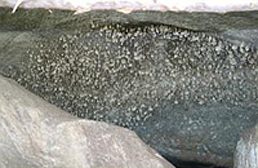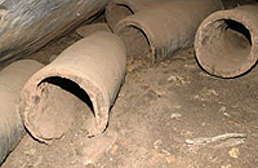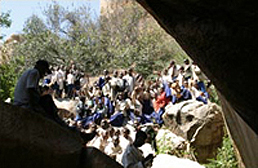 |
 |
Conservation and Management |
The rock art sites (in the Central Highlands of Tanzania) provide an invaluable historical record of the diverse economic and social activities of human communities and their intellectual, imaginative and emotional expressions over many millennia. This patrimony should be protected, preserved and illustrated. It should become a source of historical awareness, of culture and of education for the people of Tanzania, for Africa and for the World. Every effort should be made to save it for future generations. (UNESCO report 1980).
Ancient rock art is often found in areas where the art itself is not protected from involuntary and voluntary deterioration, yet there is ample evidence to show that with the implementation of relatively simple measures, most of the man-made deterioration can be stopped. In the case of the prehistoric rock art of Singida and the Lake Eyasi Basin, North Central Tanzania, the work of Fidelis Masao highlights the urgent need for conservation efforts.
The state of preservation of the majority of the sites in Singida, Iramba and the L. Eyasi Basin is generally poor. Equally bad conditions of preservation were also observed in the Kondoa area. M.D. Leakey remarked that even as far back as 1929, T.A.M. Nash had described the sites as being in a bad state of preservation. The sites are deteriorating so fast that unless the process is checked, most of the paintings will have completely disappeared by 2010.
Exposure to wind, rain, fluctuation of temperature, groundwater, seepage, biological growth and encrustation, all contribute to the deterioration of sites by the process known as weathering. Water and the organic acids secreted by lichen and other growths can slowly alter a sound and hard rock until it becomes chemically weathered. The building of concrete ledges to stop seepage or to increase the effectiveness of overhang, as in some Kondoa sites, has proved completely ineffective and in some cases accelerated the deterioration.
In central Tanzania, a number of the sites are also prone to strong winds for part of the year. As it blows, the wind picks up small grains of sand and pebbles that are hurled against the rock face, thus gradually contributing to the deterioration. In addition, the wind knocks off small flakes, which might otherwise have held on to the rock face for a longer time, finishing off the process started by the fluctuations of temperature.
Despite these numerous natural elements of deterioration, vandalism is by far the most pernicious threat to rock painting sites in Singida, Iramba and Mbulu. Visitors’ habit of writing names, initials, dates, slogans and all sorts of graffiti unfortunately seem to be on the increase. School children are perhaps the most notorious perpetrators. They use white and coloured chalk, charcoal, crayons and even industrial paint on the rock faces, causing serious damage to the paintings. Equally destructive, is the practice by some herders of using the rock shelter as a temporary kraal for their cattle. As the cattle rub against the painted rock panel, they accelerate the process of deterioration.
Of late, the worst culprits have been the cave robbers in search of German gold coins. Over the last few decades, some unscrupulous people spread the idea that the paintings were markings executed by the Germans during and after the First World War as identification symbols for shelters under which they had buried some treasure, supposedly including German coins and gold. The rumour spread so fast and extensively that almost every other painted rock shelter has now had its ground excavated, which has badly disturbed archaeological deposits. In their greed for immediate wealth, the culprits make big fires at the base of the shelters or use dynamite to crack and thus easily break the rock. Unfortunately there is still much evidence that this practice continues to this day.
As the recent expedition in 2003 to further document the sites by Fidelis Massao and Peter and Annabel Sykes shows, significant deterioration, man made or natural, is continuing and in some cases accelerating.
Looking for Gold :
A typical hole in Guwe made by locals looking for gold. The digging not only disturbs potentially vital archaeological deposits but also significantly weakens the rock face.
Graffiti :
Many of the sites are spectacular both by the size of the rock face and the extensive view of the surrounding landscape. This has made them a natural place of interest where children and local people gather causing damage through fires and graffiti.
Hornets’ Nests :
Hornets’ nests are often found on the rock sites, causing serious degradation to the rock face and paintings. Bird colonies also affect the paintings.
Honey :
A number of rock paintings indicate drawings that resemble a ladder. We found a number of ladders at or near the sites that are used to collect honey. Bee hives are also a natural source of degradation.
Local population :
The explosion in the size of the local population has certainly been one of the most dramatic causes of destruction of the rock art. Paintings hidden for hundreds of years have now been exposed to the elements because of the clearing of thick protective vegetation to make land available for farming.
Drums :
Many of the sites still maintain a religious significance for the local people. Evidence of recent rituals could still be observed. Local rituals or celebrations often include making fires, which significantly degrade the paintings.
The most effective conservation measures have not yet been discovered and even with the appropriate knowledge, Tanzania may lack the resources and technology to implement them. Alternatively, it should be possible and relatively cheap to stop or reduce vandalism. Little has been done to include the local people in any conservation effort and this has distanced them from these sites, which form an integral part of their heritage. Due to the visits by governmental officials and scientists, the sites are often shrouded in an aura of mysticism. While this raises curiosity it does little to help their preservation.
It is vital that the local people be fully involved in any management programmes of these prehistoric rock art sites. Much can be done to raise awareness about the importance and historical significance of the rock paintings. By doing so it should be possible to instil a sense of pride and ownership in the paintings, which would go much further to protecting them than metal bars and wiring. More importantly it is critical to pursue further research and use the new photographic technology now available to record this vanishing patrimony. In particular, the use of some of the latest digital photography and three-dimensional laser modelling should be investigated.
→
Rock Art in Tanzania
→
Tanzania Rock Art - Forward by Dr. Meave Leakey
→
Overview of Tanzania Rock Art Sites
→
Tanzania Conservation & Management
→
Tanzania Rock Art Sites|
1-2 |
3-6 |
7-9 |
10-12 |
13-14 |
15-16 |
17-18 |
19-21 |
22-24 |
25-26 |
→
Africa Rock Art Archive
→
Bradshaw Foundation
Like us on Facebook & Follow us on Twitter to receive news & updates:
